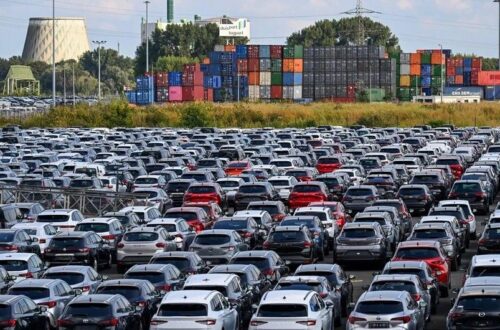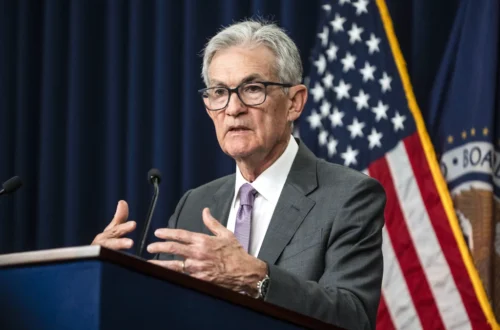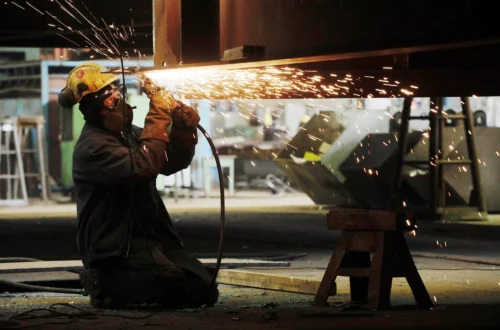On August 8, 2025, former President Donald Trump took to his Truth Social platform to issue a dire warning: if the courts strike down his sweeping tariff policies, the United States could face an economic collapse reminiscent of the Great Depression of 1929. This bold statement has sparked heated debates among economists, policymakers, and everyday Americans. But what’s behind this warning? Are tariffs truly the linchpin of America’s economic prosperity, or is this an exaggerated claim meant to rally support? Let’s unpack the issue, explore its implications, and separate fact from rhetoric in a way that’s clear, engaging, and grounded in reality.
The Context: Trump’s Tariff Strategy
Trump’s trade policy has been a cornerstone of his economic agenda, both during his first term and since his return to the White House in January 2025. His administration has leaned heavily on tariffs—taxes imposed on imported goods—to address trade imbalances, protect American industries, and generate revenue. Using the International Emergency Economic Powers Act (IEEPA) of 1977, Trump has imposed tariffs on imports from over 90 countries, including a 10% baseline tariff on all trading partners and higher rates for countries like Canada, Mexico, and China.
Why Tariffs Matter to Trump
The former president views tariffs as a tool to level the playing field in global trade, arguing that they protect American workers and reduce the trade deficit. He’s claimed that “hundreds of billions of dollars” are pouring into the U.S. Treasury, boosting the stock market and national wealth. In reality, the Treasury Department reported $152 billion in customs duties collected through July 2025—a significant sum, but not the “trillions” Trump has suggested.
The Legal Battle: A Threat to Tariff Authority
At the heart of the controversy is a legal challenge to Trump’s use of the IEEPA to impose tariffs. The 1977 law grants the president authority to regulate commerce during national emergencies but doesn’t explicitly mention tariffs. Critics, including small businesses and states, argue that Trump’s broad application of the law oversteps his authority and requires Congressional approval. In May 2025, the U.S. Court of International Trade ruled against the administration, and the case is now under review by the U.S. Court of Appeals for the Federal Circuit, with a potential appeal to the Supreme Court looming.
The Court’s Skepticism
During a July 31, 2025, hearing, the Federal Circuit’s 11-judge panel expressed doubts about the legality of Trump’s tariff strategy. They questioned whether the IEEPA grants the president the power to impose such widespread levies without Congressional oversight. A ruling against the administration could force the government to refund billions in duties, a prospect that Trump and his legal team argue would be catastrophic.
Trump’s Warning: Economic Disaster or Hyperbole?
Trump’s claim that striking down tariffs would trigger a “Great Depression” has raised eyebrows. He argues that the loss of tariff revenue—combined with the need to refund duties already collected—would devastate the economy, wipe out jobs, and threaten programs like Social Security and Medicare. But is this a realistic scenario, or is it political theater? Let’s break it down.
The Great Depression Comparison
The Great Depression of the 1930s was a global economic catastrophe marked by mass unemployment, bank failures, and a GDP collapse of nearly 30%. Trump’s warning suggests that a court ruling against tariffs could lead to a similar calamity. However, economists like Gregory Daco of EY-Parthenon argue that the $70–80 billion in additional tariff revenue collected in 2025 is a “drop in the bucket” compared to the federal government’s $7 trillion budget.
Economic Impact of Tariffs
To understand the stakes, let’s look at the role tariffs play in the U.S. economy. Tariffs generate revenue and protect domestic industries, but they also raise costs for consumers and businesses. Here’s a quick overview:
- Revenue Generation: Tariffs have contributed $152 billion to the Treasury through July 2025, a fraction of the federal budget but a notable boost to government coffers.
- Consumer Costs: Economists estimate that Trump’s tariffs equate to a $1,300 tax increase per U.S. household in 2025, as higher import prices are passed on to consumers.
- Stock Market Effects: While Trump credits tariffs for record stock market highs, analysts like Art Hogan of B. Riley Wealth Management argue that markets have rallied when tariffs were scaled back, not imposed.
Pros and Cons of Tariffs
Let’s weigh the benefits and drawbacks of Trump’s tariff policy to get a clearer picture:
Pros:
- Protects domestic industries like steel and manufacturing by making foreign goods less competitive.
- Generates government revenue, which can fund infrastructure or reduce deficits.
- Pressures trading partners to negotiate better trade deals, as seen in Trump’s first term.
Cons:
- Increases costs for consumers, effectively acting as a “shadow tax” on imported goods.
- Risks retaliatory tariffs from other countries, potentially harming U.S. exporters.
- Stokes inflation, with some economists warning of rising prices across industries.
The Economic Reality: Would a Court Ruling Trigger Disaster?
Economists and budget experts largely dismiss Trump’s claim of an impending economic collapse. Jessica Riedl of the Manhattan Institute notes that the loss of tariff revenue wouldn’t cause a “budgetary earthquake” given the U.S.’s $2 trillion deficit and $7 trillion budget. Social Security and Medicare, funded primarily by payroll taxes, would remain unaffected. Moreover, a court ruling against tariffs could reduce consumer prices, potentially stimulating the economy.
A Historical Perspective
To put things in context, I recall my grandfather telling stories about the Great Depression—lines for bread, shuttered businesses, and a pervasive sense of hopelessness. Comparing that to the potential loss of $152 billion in tariff revenue feels like a stretch. The U.S. economy is far more diversified and resilient today, with mechanisms like federal debt financing and monetary policy to cushion shocks. Still, the uncertainty of a court ruling could rattle markets in the short term, as investors hate surprises.
What Happens if Tariffs Are Struck Down?
If the courts rule against Trump’s tariffs, the fallout would depend on the ruling’s scope. Here’s a breakdown of potential outcomes:
| Scenario | Impact on Economy | Likelihood |
|---|---|---|
| Full Tariff Reversal | Refunds of billions in duties, reduced consumer prices, potential market rally | Moderate |
| Partial Reversal | Limited refunds, some tariffs remain, minimal economic disruption | High |
| Tariffs Upheld | Status quo, continued revenue but higher consumer costs | Moderate |
A full reversal could lead to a complex refund process, as businesses and importers seek to reclaim duties paid. Alan Wolff of the Peterson Institute warns of “massive red tape” in this scenario, but he doubts it would trigger a depression.
The Political Angle: Why the Hyperbolic Warning?
Trump’s dire rhetoric isn’t just about economics—it’s also a political strategy. By framing a potential court ruling as a “judicial tragedy,” he rallies his base and pressures the judiciary. Posts on X reflect this sentiment, with supporters echoing his warnings of economic ruin. However, critics argue that Trump is setting the stage to blame courts for any future economic downturn, deflecting responsibility from his policies.
A Personal Reflection
As someone who’s watched trade wars unfold from the sidelines, I can’t help but think of my friend Sarah, who runs a small retail business. She’s been hit hard by higher import costs due to tariffs, forcing her to raise prices and lose customers. If tariffs were struck down, she might breathe a sigh of relief—but she’s also worried about the uncertainty of refunds and trade retaliation. Her story mirrors the broader tension: tariffs can protect some industries but hurt others, and the legal battle adds another layer of unpredictability.
People Also Ask (PAA) Section
Here are answers to common questions about Trump’s tariff warning, pulled directly from Google’s “People Also Ask” results:
What are tariffs, and how do they work?
Tariffs are taxes imposed on imported goods, designed to raise revenue or protect domestic industries. They increase the price of foreign products, making local goods more competitive. In 2025, Trump’s tariffs have generated $152 billion but also raised consumer prices by an estimated $1,300 per household.
Why is Trump’s tariff policy controversial?
Trump’s use of the IEEPA to impose tariffs without Congressional approval has sparked legal challenges. Critics argue it’s an overreach of executive power, while supporters say it’s necessary to protect U.S. interests. The ongoing court case could redefine presidential authority over trade.
Could a court ruling really cause a depression?
Most economists doubt that striking down tariffs would trigger a depression. The $70–80 billion in annual tariff revenue is significant but small compared to the $7 trillion federal budget. A ruling could lower consumer prices, potentially boosting the economy.
Where can I learn more about U.S. trade policy?
For detailed insights, check the U.S. Trade Representative’s website (ustr.gov) or the Treasury Department’s reports on customs duties. These sources offer data on trade agreements and tariff impacts.
Comparing Tariffs to Other Economic Policies
To understand the significance of Trump’s tariffs, let’s compare them to other economic tools:
| Policy | Purpose | Impact on Consumers | Impact on Revenue |
|---|---|---|---|
| Tariffs | Protect industries, reduce trade deficit | Higher prices | $152 billion (2025) |
| Tax Cuts | Stimulate spending, boost growth | More disposable income | Reduces revenue |
| Subsidies | Support specific sectors | Lower prices for some goods | Costs government funds |
Tariffs stand out for their dual role in generating revenue and protecting industries, but their consumer cost makes them contentious. Unlike tax cuts, which put money back in consumers’ pockets, tariffs act as a hidden tax, as economist Peter Schiff has noted.
FAQ Section
1. What is the International Emergency Economic Powers Act (IEEPA)?
The IEEPA, enacted in 1977, allows the president to regulate commerce during national emergencies. Trump has used it to impose tariffs, but critics argue it doesn’t explicitly authorize such levies.
2. How much revenue do tariffs generate?
Through July 2025, tariffs have generated $152 billion in customs duties, a significant increase from previous years but a small fraction of the federal budget.
3. Would striking down tariffs hurt the stock market?
Analysts like Art Hogan argue that markets have rallied when tariffs were reduced, not imposed. A court ruling against tariffs could spark a “massive celebration” among investors.
4. Can Trump impose tariffs without Congress?
Trump claims the IEEPA grants him this power, but the U.S. Constitution requires Congressional approval for taxes like tariffs. The courts will decide if his use of emergency powers is legal.
5. What are the best tools for tracking tariff impacts?
For real-time data, use the U.S. Census Bureau’s trade statistics (census.gov) or the Tax Foundation’s tariff tracker (taxfoundation.org). These platforms offer insights into trade flows and economic impacts.
The Bigger Picture: Tariffs and Global Trade
Trump’s tariffs are part of a broader push to reshape global trade. By imposing levies on countries like China (10%) and Canada/Mexico (25% for non-USMCA goods), he aims to force trading partners to negotiate better deals. A 2024 study cited by the White House found that first-term tariffs led to “reshoring” in industries like steel, creating jobs. However, retaliatory tariffs from other nations could harm U.S. exporters, as seen in past trade wars.
A Global Perspective
I once spoke with a Canadian supplier who was baffled by the 25% tariff on non-USMCA goods. “It’s like we’re being punished for being neighbors,” he said with a wry smile. His company now faces higher costs to sell in the U.S., and he’s considering relocating production to avoid the levy. This ripple effect shows how tariffs can disrupt global supply chains, even among allies.
Safeguarding Wealth in Uncertain Times
Trump’s warning has also sparked discussions about protecting personal finances amid economic uncertainty. Some experts, like Ray Dalio of Bridgewater Associates, recommend diversifying into assets like gold, which has surged 35% in value over the past year. Real estate, a sector Trump himself championed, remains a hedge against inflation. For those looking to invest, Gold IRAs or real estate funds offer options to safeguard wealth. Learn more at goldco.com for a free guide on gold investments.
Transactional Tools for Investors
If you’re worried about market volatility, consider these tools:
- Goldco: Offers Gold IRAs with up to $20,000 in free metals on qualifying purchases.
- Fundrise: A real estate investment platform starting at $10, ideal for non-millionaires.
- TradeStation: Tracks market trends to inform tariff-related investment decisions.
Conclusion: Navigating the Tariff Tempest
Trump’s warning of an economic disaster if courts strike down tariffs is a mix of bold rhetoric and genuine concern. While the loss of tariff revenue wouldn’t likely trigger a Great Depression, it could disrupt his trade strategy and create short-term market uncertainty. For everyday Americans, the real impact is felt at the checkout counter, where higher prices reflect the cost of tariffs. As the courts deliberate, the debate underscores a deeper question: how much power should one president have to reshape global trade?
By staying informed through reliable sources like the U.S. Trade Representative or the Tax Foundation, you can navigate this complex issue with confidence. Whether you’re a business owner like Sarah, an investor eyeing gold, or just a curious citizen, understanding the stakes of this tariff battle is crucial. The courts will soon decide, but one thing’s clear: the outcome will ripple far beyond Washington.




